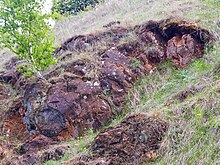Capuchin stone
Kapuzinerstein is a sandstone that is colored from light to dark rust brown and occurs in the Leiningerland , Bad Dürkheim district , Rhineland-Palatinate . Its name is derived from the capuchin habit of the same color .
nature
It is a sandstone, formed from sand and brown iron solutions, which, despite its softness, was often used as a building or decorative stone because of its attractive rust-brown, sometimes red-brown color.
Occurrence
The main deposit is in the Eistal , north and south of the state road 395, on the boundary between Asselheim and Mertesheim , almost exactly at the level of the former Neumühle, and the Loh- or Gaulschen Mühle a little west of it. The former has now been converted into a waterworks, the latter has since been demolished. Its location was south of the Eisbach , where a ravine branching off from the Mertesheimer Weg on the Grünstadter Berg and spanned by a bridge of the Eistalbahn leads down, which joins the L 395 over a brook bridge. Here, to the right and left in the valley slopes, the earlier quarries can still be seen, but they are more and more overgrown by the thicket. The area in the side valley (hollow path) coming down from the Grünstadter Berg, at the former Lohmühle, has been called the “sand castle” in Grünstadt because of the sandstone cliffs there .
There are other deposits of the Kapuzinerstein in nearby Ebertsheim , in Neuleiningen and in Battenberg .
History and use
It is possible that the stone was already mined in Roman times, but certainly in the Middle Ages. Capuchin stones from the Eistal were built in both the Worms Cathedral and the neighboring St. John's Church from the 12th century; in the 13th century at the Liebfrauenkirche Worms and at the Elisabeth Church Asselheim , whose entire tower consists of it.
The material was still being used on buildings in the region at the end of the 19th century. The Grünstadt train station, built in 1873, and the school in Battenberg are examples of this. At the beginning of the 20th century, mining stopped.
literature
- Communications from Pollichia , 1939, p. 128; (Clipping scan 1) ; (Detail scan 2)
- Geognostische Jahreshefte , 1919, p. 144; (Detail scan)
- Walter Bucher: Contribution to the geological and palaontological knowledge of the younger tertiary in the Rheinpfalz , Munich, 1913, Geognostische Jahreshefte, No. 26, pp. 1–103; (Detail scan)
- Pollichia annual report , volumes 25–27, p. 89, Bad Dürkheim 1868; (Digital scan)
- L. Rau: Studies on southern German agriculture: the cantons Frankenthal and Grünstadt in the Bavarian Rhine Palatinate, presented statistically, economically, and agriculturally , Speyer 1852, p. 22; (Digital scan)
Web links
- Files on the construction of the Siegfried pharmacy in Rheingönheim, 1908, with reference to the use of Kapuzinerstein
- Photo of the Siegfried Pharmacy Rheingönheim, with ground floor made of Capuchin stones
Individual evidence
- ^ Walter Hotz: Der Dom zu Worms , Wissenschaftliche Buchgesellschaft, 1981, p. 43, ISBN 3534074122 ; (Detail scan of the Kapuzinerstein at Worms Cathedral)
- ^ Josef Hubert van Endert: Organ for Christian Art , Cologne, 1873, page 117 of the volume; (Digital scan)
- ^ Fritz Bender: The Church of Our Lady in Worms: a contribution to the history of architecture on the Middle and Upper Rhine in the 14th century , 1922, p. 39; (Detail scan)
- ↑ Annual report of the Rhineland-Palatinate Foundation for Culture, 2009 , p. 44 (PDF document with reference to the reuse of Capuchin stones from the Grünstadt train station in Sausenheim)
- ^ Georg Peter Karn, Rolf Mertzenich, Ulrike Weber, Herbert Dellwing: Monument topography Federal Republic of Germany: Cultural monuments in Rhineland-Palatinate , Volume 13: Bad Dürkheim district , p. 238, Wernersche Verlagsgesellschaft, 2006, ISBN 3884622153 ; (Detail scan)
gallery
Old picture of the Liebfrauenkirche in Worms . The decorative stones of the towers made of Capuchin stone (painted over today)
Tower of prot. Elisabeth Church Asselheim , mainly made of Capuchin stone
Grünstadt station , ground floor made of Capuchin stones











